Make a corflute roundshield
By Idiot/Savant
You’ve just started larping and you want to get a bunch of shields to kit out your players and your crew gear pool. You can buy them for $170 a pop from Paddywhack (and they will look cool and they will rock) - or you can get together with your friends and churn out a bunch of them for $20 a pop. Here’s how.
These shields are a cheap and easy way to equip a crew gear pool. And they’re durable - my oldest roundshield is four years old and hasn’t failed yet.
##Safety standards
Before we get started, the most important rule: Make sure the shield you are making meets the safety standard for the game you are playing in.
There’s no point making something you can’t use. So, check whether they’re happy with a padded corflute body, and find out what they prefer for a boss. Some games are happy with plastic, others will want foam. Make sure you choose the right option for the games you expect to play.
##What you need
[ul]
[li] Corflute: 3 standard real-estate signs per shield.[/li]
[li] Foam camp-mat ($17 for a 1.8 x 1m roll at the Warehouse)[/li]
[li] Leather or suede for grips[/li]
[li] 0.8m square of plain fabric for the back[/li]
[li] 0.8m square of coloured fabric for the front.[/li]
[li] Scrap fabric[/li]
[li] ADOS multipurpose spray adhesive (“Spraydos”) (~$20 for a spraycan from Mitre 10)[/li]
[li] ADOS F2 contact cement ($20 for 500 mL from Mitre 10)[/li]
[li] Duct-tape[/li]
[li] Staple-gun and lots of staples[/li]
[li] Metal ruler[/li]
[li] A compass, able to draw a circle of at least r=30cm. If you don’t have one, you can make one from a scrap of corflute.[/li]
[li] Craft knives and spare blades[/li]
[li] Foam brushes (get a couple of 10 packs from your local $2 shop)[/li]
[li] A pen[/li]
[li] Bricks, a spare set of Britannicas, or something else you don’t mind using as weights.[/li]
[li] Acrylic paints: black and silver at minimum, plus whatever you want for decoration.[/li]
[li] Space[/li][/ul]
If you’re going with a plastic boss, you will also need:
[ul]
[li] Plastic picnic bowls: one per shield ($3 for a 4 pack at K-mart).[/li]
[li] A belt sander or vibrational sander[/li][/ul]
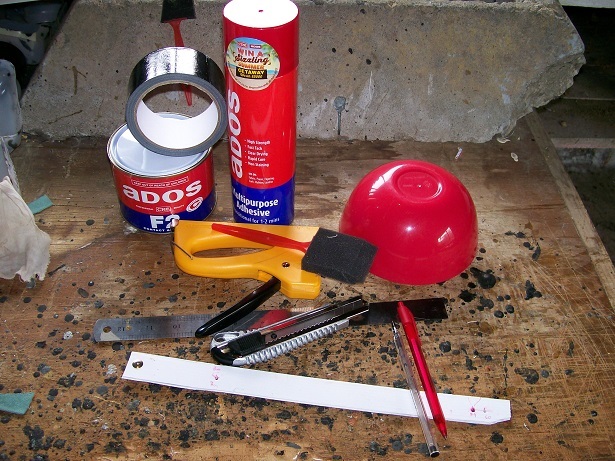
Tools for shield-making
Does not include sander. The thing at the front is my DIY compass: a piece of scrap corflute marked with holes for the boss (7cm) and 59cm and 60cm shields.
A note on corflute: If you need corflute in Auckland, talk to Mike Curtis. If you need it in Wellington, talk to Idiot. Both of us make a point of collecting it for NZLARPS use whenever we get the chance. If you want to acquire your own, try asking real-estate agents, politicians, and bottle-stores.
A note on foam: the warehouse camp-mat varies a lot in its density, so check how hard it is. Generally I’ve found the brown to be too hard and the light grey to be too soft (meaning it tears when you try to cut it). Dark grey, blue or yellow seem to work fine.
A note on glue: Store your ADOS carefully. Its full of nasty organic solvents, which volatilise on warm days. If you leave it in direct sunlight (or, say, in the front seat of a car), the pressure will pop the lid off, possibly getting glue everywhere in the process. I store mine on a cool shady shelf to stop this from happening.
ADOS is contact cement - meaning that you apply a thin layer to each surface, then wait for it to dry. Once you press them together, the bond will be strong - so don’t make a mistake.
Don’t buy the ADOS “Ultra-high strength instant bond on contact” stuff. While it comes in a can, its not an aerosol spray. You can use it to stick corflute together, but you’re not going to be able to use it for your covers, or to bond paint to your bosses.
A note on space: You’re going to need a lot of it, and its going to get messy from ADOS, foam scraps, and latex. You’re also going to need to be able to leave sandwiches overnight under bricks, or hang weapons up while the latex is drying. A garage is perfect. A kitchen probably isn’t.
##Planning
The basic plan is for a sandwich of multiple layers of corflute, which will be edged and faced with foam camp-mat. The back and front will be covered with cloth, and then a plastic or foam shield boss will be glued on to cover the handle.
Lay out your corflute. See how it has those lines in it? Those are the internal corrugations. You’re going to make a sandwich, with those corrugations running perpendicular to one another in alternate layers to provide strength. That way, it won’t just fold when someone pushes on it hard, because there’ll be another layer with corrugations resisting the fold.
How many layers you need depends on the thickness of the corflute. For standard real estate or political signs, I use three layers, running vertical (down the handle), horizontal, and vertical (I arrange them this way to maximise the strength of the handle, since its the weakest point). If you have thicker corflute, you can get by with only two layers. If you have lots, you can use four, but that seems like overkill. If you have offcuts, you can test the strength by stacking some and attempting to fold it.
Work out which way round your corflute is going to go. You will want a plain surface at the back. No-one wants a real-estate agent staring at them from the back of their shield.
Work out how big you want to make your shield. A standard real estate or political sign is about 60cm x 90cm, so if you’re careful you can get a 60cm shield out of it. Try to work in complete layers - a split is a weak-point, especially if it follows the same direction as the corrugations in another layer.
For this example, I will be working with 2-layer shields made out of thicker corflute, and cutting to a diameter of 58 cm (which the padded rim will then bring up to 60cm).
You can use other shapes. You should be able to get a 60cm x 90cm oval or teardrop shield out of a standard sign. There are several walk-throughs of how to make a heater (knights) shield in the Gear forum.
##Making the core
First, draw out your circles. Pick a centre point, lay down your compass, and draw two circles: one for the boss (7cm radius) and one for the edge. The boss won’t be completely cut out; instead you will need to leave a strip ~1 inch wide across it for the grip. So the final shape will be like a big fat “phi”.
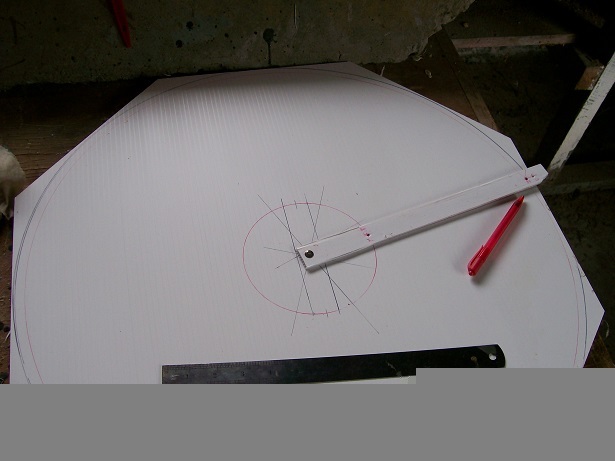
Drawing the shield: The construction lines are so I could find the centre of this octagonal sign. The boss is r = 7cm and the edge is r = 29cm. I’ve also drawn in the handle, which goes along the corrugations. The next layer will have the handle perpendicular.
Next, cut it out. Double check the direct of your handles before cutting - you need to make sure that alternate layers run perpendicular to each other.
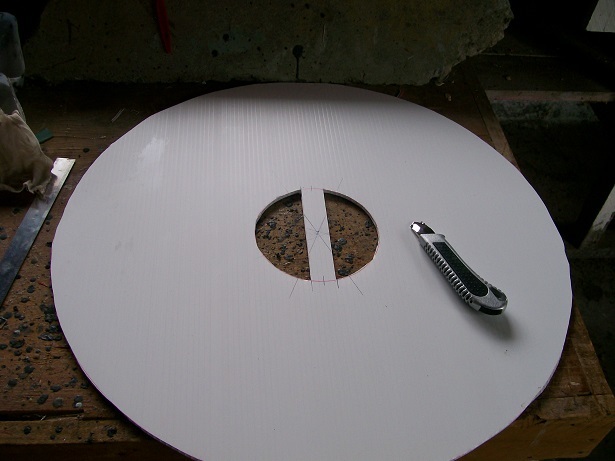
Reinforce the handle on the middle layer (or the front if you are making a 2-layer shield). You can do this with a strip of cloth and some ADOS, or you can use duct-tape. Apply the reinforcements to both sides.
I haven’t had a handle break on one of these yet, and my oldest one is five years old. But why take the chance?
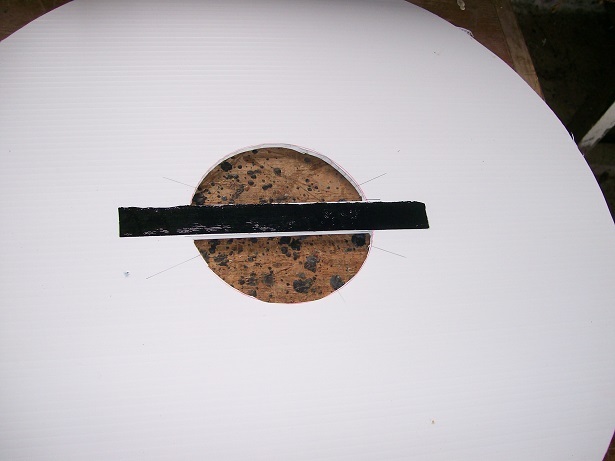
Next, make the sandwich. Lay down the first two layers of your shield and spray them with SprayDOS. Wait for it to tack off, then line them up as best you can and stick them together. Press it all down hard (I hold mine up against a wall and give it a good pounding while rotating it). Repeat until you have all your layers glued together.

When you’ve made your sandwich, put it under bricks. Leave for at lest 24 hours, until the glue cures.
Once the shield has cured, trim the edges. Basicly you want to smooth it off a bit and make it level for the next stage.
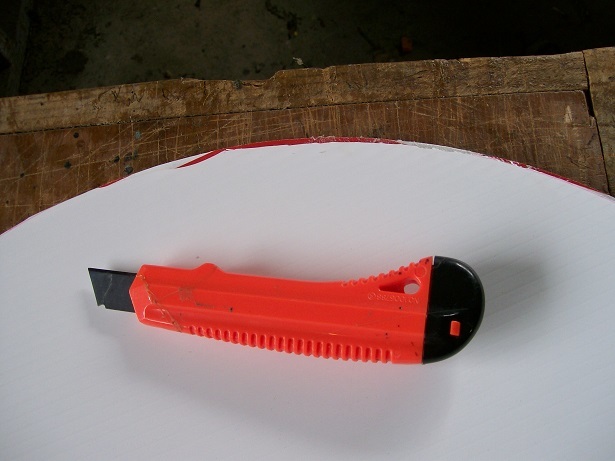
See that red bit? It has to go.
Once you’ve trimmed the edges, go all around it with duct-tape. This will take some time, but its easy to do in front of the TV. You need to do this to provide a smooth surface to glue the rim to.

Next, edge the shield in foam campmat. Cut a 1 inch (ruler-width) strip from the edge of your campmat, and apply a thin layer of ADOS to it with a foam brush. While its tacking off, do the same to as much of your shield as you can (~half to three quarters, depending on what you’re leaning it against). Stick the foam to the gluey part of the shield, making sure to line it up with the front of the shield. Work your way around, apply glue to the rest of the shield rim, stick the rest of your foam strip down. Cut more foam edging as appropriate (a 60cm shield will need at least 190cm of edging). Make sure to glue the ends of the foam to each other. When you’re done, your shield will have an oversized rim, like this:
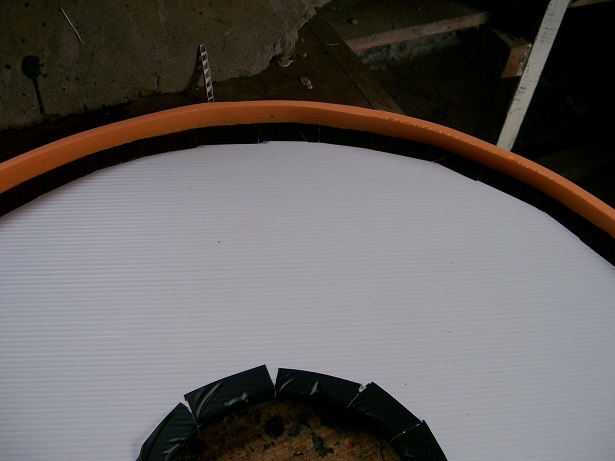
Leave that to cure for a while. When its done, cut the excess width of foam off, like so:
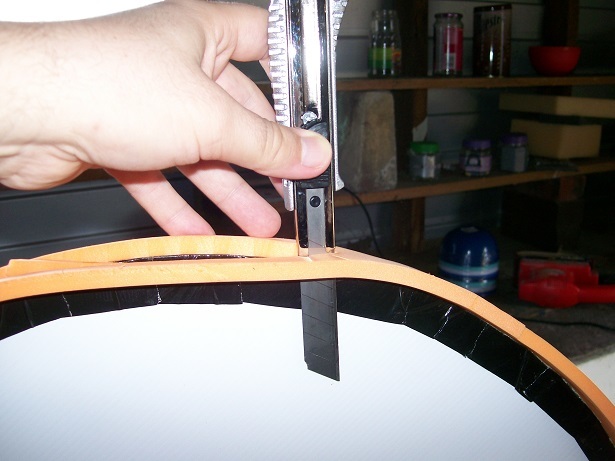
Cut out a chunk of foam slightly larger than the shield. It doesn’t have to fit exactly, since you’re going to trim it later. Mark the edges and the centre hole.
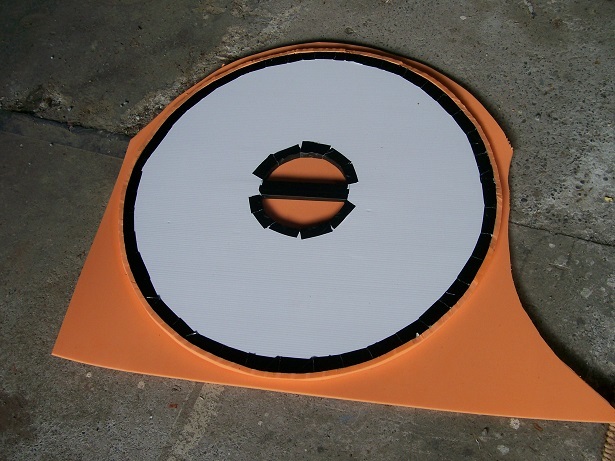
ADOS time. First, give both foam and shield a good coat of SprayDOS. Then, using the markings you made earlier, go round the outer and inner edges with ADOS as well. This provides a solid bond on those bits.
When it has tacked off, glue it together. When that’s done, quickly trim the excess foam off the face, exposing the edges:
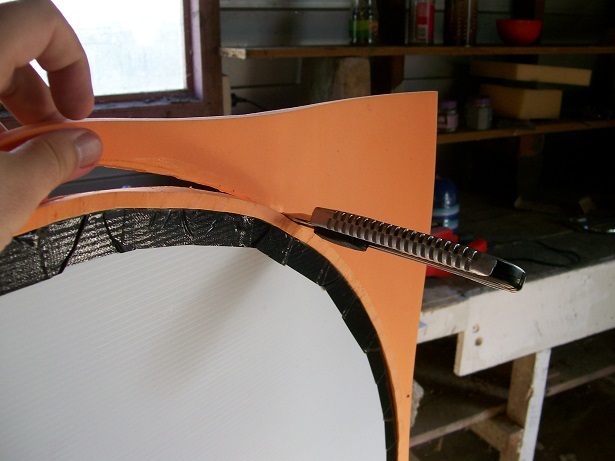
Go round the edge; if you see any gaps, then press them together. That’s what that extra ADOS is for. When you’re done, stick it under bricks overnight to cure:
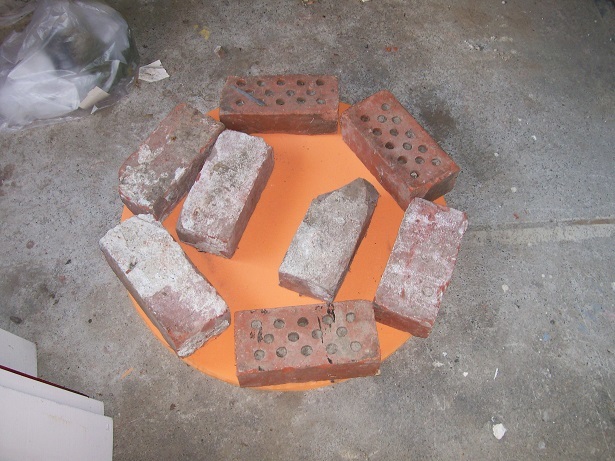
When it has dried (or before, I suppose, it doesn’t matter), cut out the hole for the grip:
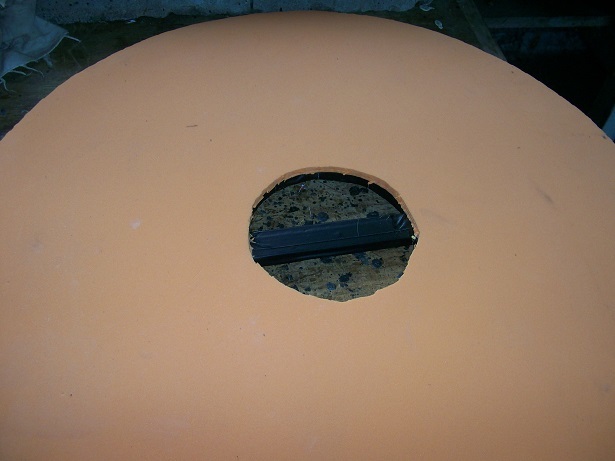
Congratulations, you have now finished your shield core! Next step: covering it.
##Covering
No-one likes to look at orange foam, so you will want to cover your shield. You can use a variety of materials for this. Leather looks cool, but is expensive, but give you the option of creating raised patterns under it by gluing stuff to the shield face. Because I like simple shields with painted designs, I use fabric. Never use white fabric, as the underlying foam will show through when it gets wet. Instead, use a dark colour and paint any white bits on. If you must have a plain white shield, you’ll probably have to put something under the cover as a liner first to hide the foam. I’ve never done it, but SprayDOS is your friend here.
No-one likes to look at white corflute either, so you’ll need to cover the back of your shield as well. Again there are options. I use a loose-weave brown fabric, largely because I have an enormous amount of it. Start by cutting out a square of your backing and laying it flat. You’ll need it to stick well, so you’ll need to SprayDOS it twice. So, SprayDOS it, leave it for a bit, then do it again with the shield.
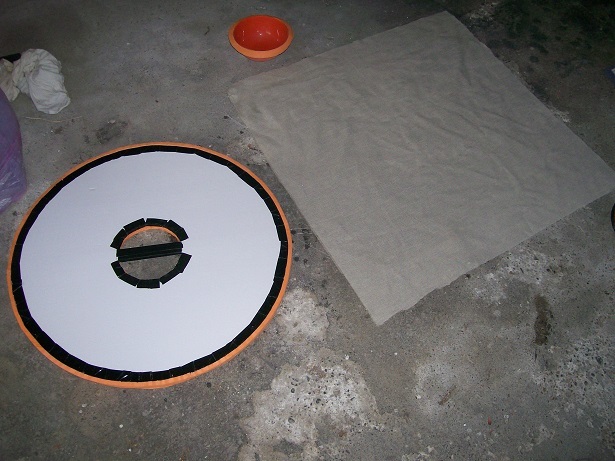
Plant the shield on your backing fabric, flip it over, and smooth it out. You may need to peel up an edge to work out a bubble or wrinkle. Do this quickly, them trim off all the extra bits (including the centre):
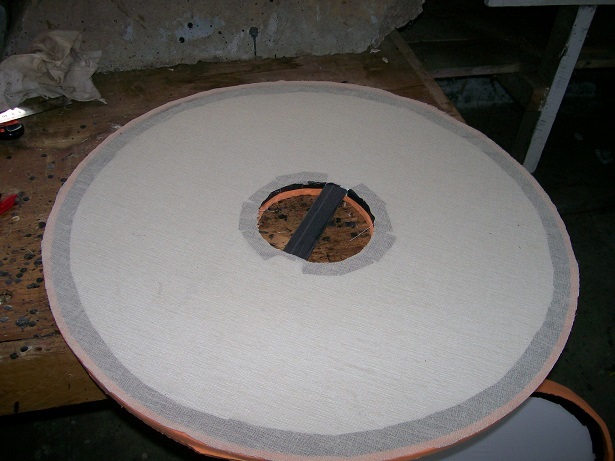
Now the front. Its a slightly different process here. First, cut it to a circle, with an extra 5cm around the edge. This is so you can turn it over and staple or glue it down on the back. Second, iron it flat before spraying. This will reduce bubbles and wrinkles. After that its the same - double-spray the fabric, single-spray the shield:

Smooth it out as before. There are a few bubbles and wrinkles in this:
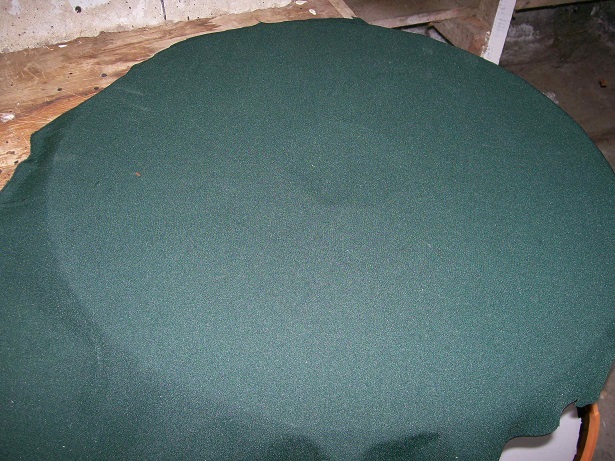
You’ll be attaching the cover on the other side, so when it comes to trimming the centre hole, simply cut it into wedges using the grip as a guide:
After that, its staplegun time! Pull your centre wedges through, fold them over, and staple them (the grip ones can be stapled directly to the grip on the other side). Then go round the edge, cutting every ~3cm or so. Fold over the edge to prevent fraying, and staple it to the corflute. Try and overlap your fabric so you’re stapling through multiple sections.
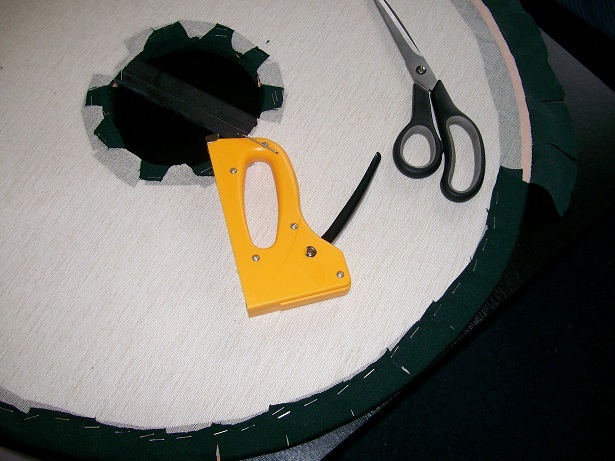
If you don’t like staples, you can also glue the edge, but its messy and takes longer.
Once you’ve got the edge stuck down, do the grip. You can spiral wrap it, but a simple rectangle of leather works fine. ADOS it down:

And now you’re covered and gripped. Only one thing remains: the boss.
##The boss
The shield boss is the dome that goes in the middle to protect your hand. You have some options here. First, you can make a foam shield-boss using the pattern here. You can cast a pretty shield boss out of latex, or buy one over EBay. I use plastic bowls because they’re cheap and easy to modify (see appendix). Whichever you choose, you need to mount the thing.
First, work out where its got to go. Measure the distance from the edges until its right in the middle of the shield:

Mark the position by drawing round the edge:
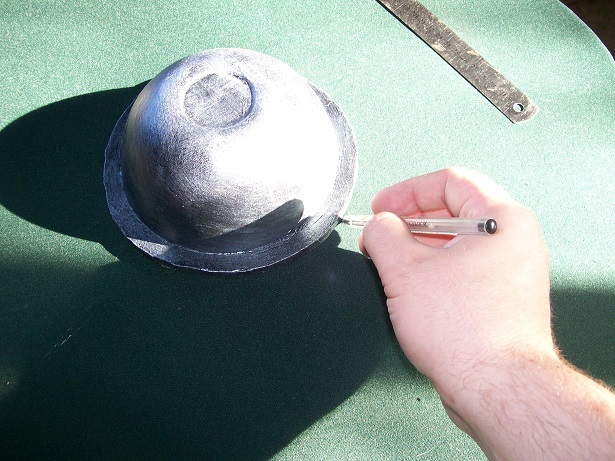
ADOS time:
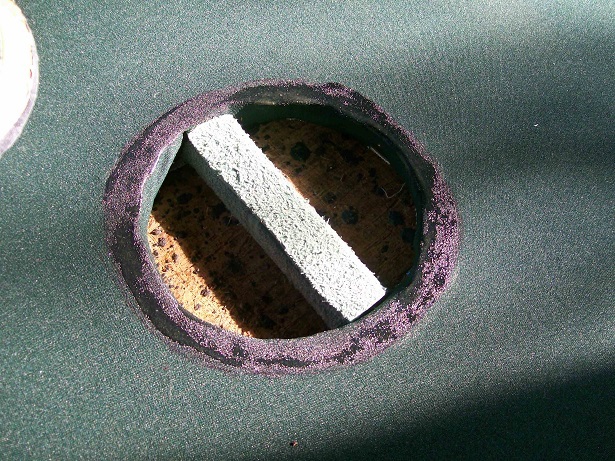
And press it down:
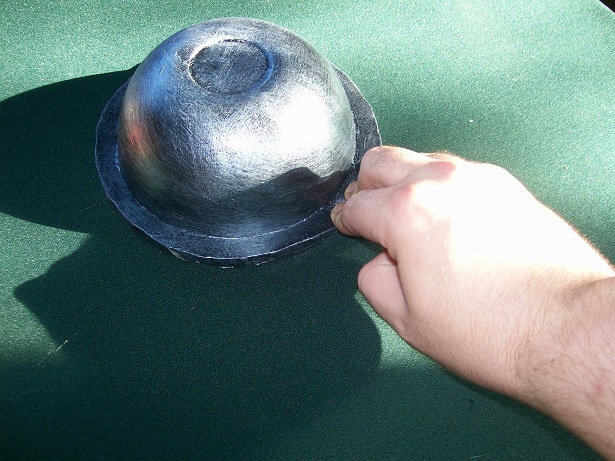
And you’re done! You now have a corflute shield!
##Maintenance
If you avoid sitting on it or accidentally barging anyone with it, your shield should last a long time. I made my first one of these in 2011 and its still fine. However, they do need maintenance. If you didn’t staple your cover tightly, some of the flaps on the back may come lose; you can simply restaple them. The paintwork on the boss will get chipped in combat, so you will need to repaint it every so often. Worse, if mistreated or whacked hard with a two-handed weapon, the boss may become loose from its rim (thinner bowls may break). Sometimes you can just glue it back in. Otherwise, you need to carefully cut the whole boss and rim away from the shield, re-rim and re-paint the boss, and glue it back on. This may damage the cover, so be careful and repaint any design as needed.
If the worst happens, you should be able to recycle at least some of your shield (the boss and cover) into the next one. But after four years and nearly twenty of these things, that hasn’t been necessary yet.
##Appendix: making a boss from a plastic bowl
Take a plastic picnic bowl (sold in packs of 4 for ~$3 at K-mart). First, you will need to sand off any external markings, such as “Made in China” or a recycling symbol. I use a vibrational sander for this, but you could use sandpaper. While you’re at it, roughen up the surface so paint will stick to it:
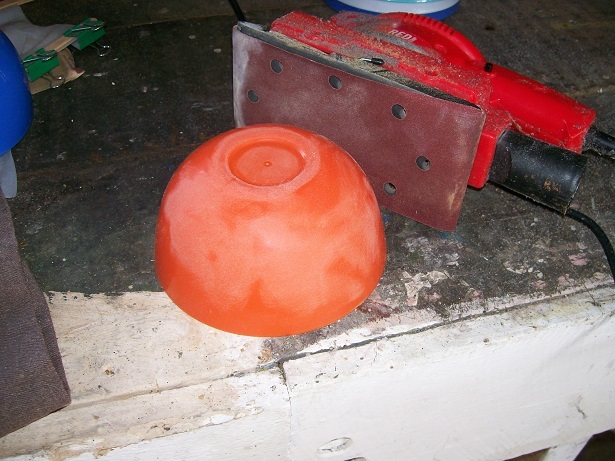
Next, get a strip of foam long enough to go all the way around when edge-on. Offcuts from your shield rim are perfect for this. Check that it is wide enough, then ADOS the edge of the foam and the bottom of the bowl and leave it to tack off:

Glue your strip of foam edge-on to the bowl:
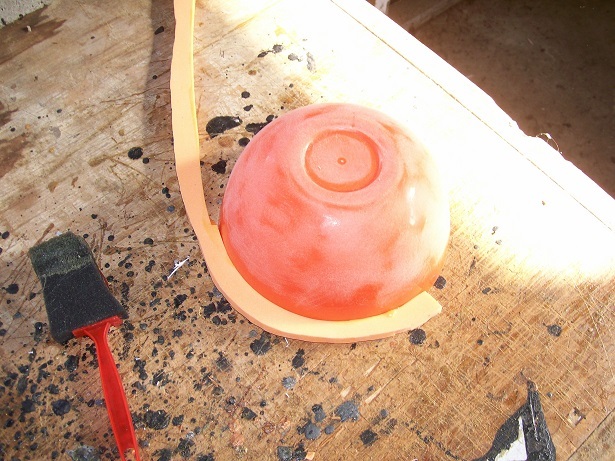
If you’re like me, you will make your foam a bit long. So stop just before you get to the end, measure where the foam needs to go to, cut it and ADOS the end. When its dry, continue:
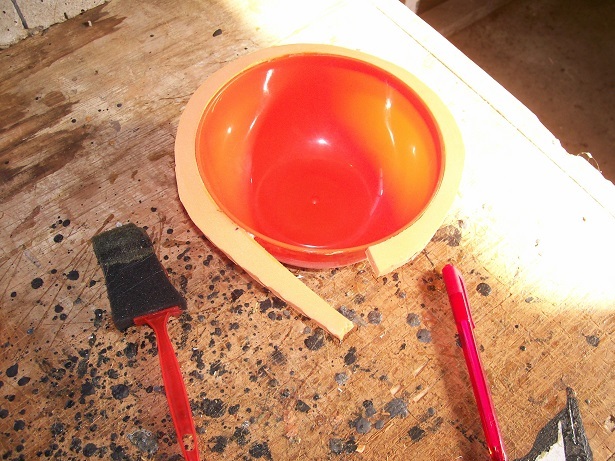
The completed boss (yes, its a different one, and no, I didn’t sand it to roughen it):
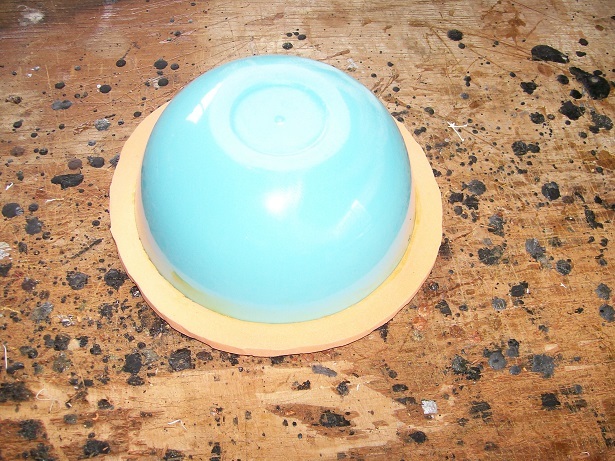
Next, paint it. Because paint doesn’t stick well to smooth plastic (such as the inside of your bowl) you will need to give it something to stick to. Because I can’t fit my vibrational sander inside the bowl, I just give it a blast of SprayDOS when doing something else (that’s what all those shield bosses lined up in the photos above are there for). You can also do this to the outside if you have failed to sand it.
As for paint, I go for two coats of black as a base. Do not paint the bottom of the rim - you want to glue the foam to the shield, not just its paintjob. When the outside has been given its base coat, drybrush it in metallic silver. This means you get some paint on your brush, wipe most of it off, and smear it around to highlight any surface features. The end result looks something like this:
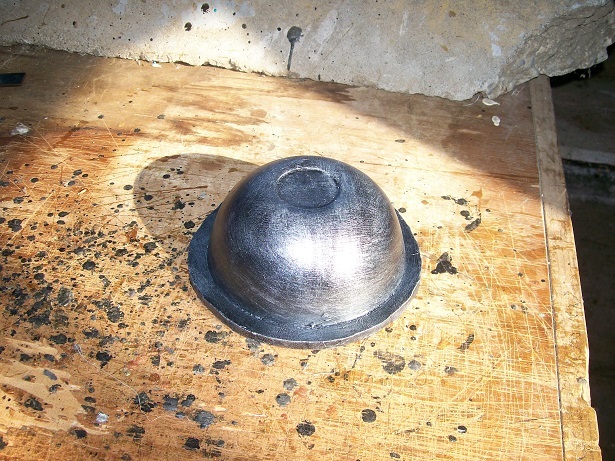
And now you can stick it to your shield.
